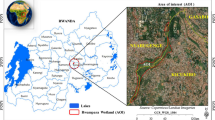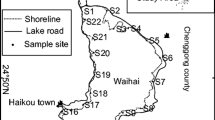Abstract
Whether dam impoundment for water resource purposes improves wetland ecosystems is heavily disputed. In this study, we investigated the effects of dam impoundment from 2006 to 2011 on wetland plant communities and wintering water birds in Lashi Lake, a typical closed wetland in Northwest Yunnan, China. The surface area of the water body increased from 933 hm2 before impoundment to 1262 hm2 after impoundment; the area of meadows and emergent, submerged and floating vegetation increased from 1006 to 1149 hm2. After the dam impoundment and with the rising water level, formerly dominant plant communities, such as Com. Phragmites australis, Com. Potamogeton pectinatus and Com. Nymphoides peltatum, disappeared. New communities, such as Com. Polygonum hydropiper, Com. Acorus calamus and Com. Leersia hexandra, rapidly expanded into the newly formed lakeside. During these changes, the species and number of wintering water birds slightly increased, but the populations and distributions of birds were altered. Some birds chose the newly formed lakeside as habitat, while others disappeared or decreased greatly. Notably, the major protected birds, such as species of Ciconia nigra, did not appear in the new area, and the species number of Grus grus decreased. The results showed that damming impacted wetland ecosystems. Given the importance and complexity of dam impoundment in alpine wetlands, the effects of food-chain modifications on plants, water birds, aquatic organisms, and humans could be extensive.





Similar content being viewed by others
References
Armitage AR, Jensen SM, Yoon JE, Ambrose RF (2007) Wintering shorebird assemblages and behavior in restored tidal wetlands in Southern California. Restoration Ecology 1:139–148
Bird J, Wallace P (2001) Dams and development-an insight to the report of the World Commission on Dams. Irrigation and Drainage 50:53–64
Chen XY, Yang JX, Chen ZM (2003) Fauna and status of fishes in Lashihai nature reserve in Lijiang. Zoological Research 24:144–147
Cody B (2007) Undam It-Impacts on Riparian Wetlands from the Removal of Small dams. Penn State University 1–16
Cui BS, Yang QC, Yang ZF, Zhang KJ (2009) Evaluating the ecological performance of wetland restoration in the Yellow River Delta, China. Ecological Engineering 35:1090–1103
Dynesius M, Nilsson C (1994) Fragmentation and flow regulation of river systems in the northern third of the world. Science 266:753–762
Erwin RM (1983) Feeding habitats of nesting wading birds-spatial use and social influences. Auk 100:960–970
European Commission (2000) Directive 200/60/EC of the European Parliament and of the Council of 23 October 2000 establishing a framework for Community action in the field of water policy. Official Journal of the European Communities 1:327
Farrier D, Tucker L (2000) Wise use of wetlands under the Ramsar Convention: a challenge for meaningful implementation of international law. J Environ Law 12(1):21- +
Forcey GM, Linz GM, Thogmartin WE, Bleier WJ (2007) Influence of land use and climate on wetland breeding birds in the Prairie Pothole region of Canada. Canadian Journal of Zoology 3:421–436
Hoover JP (2006) Water depth influences nest predation for a wetland-dependent bird in fragmented bottomland forests. Biological Conservation 1:37–45
Hopkinson CS, Vallino JJ (1995) The relationships among man’s activities in watersheds and estuaries: a model of runoff effects on patterns of estuarine community metabolism. Estuaries 18:598–621
Huang YC, Tian K, Yue HT, Liu ZP, Lai JD (2012) Effects of dam impoundment on lakeside vegetation succession in the plateau wetlands of the Lashi Lake. Resources and Environment in the Yangtze Basin 21:1197–1203
Kingsford RT, Thomas RF (2004) Destruction of Wetlands and Waterbird Populations by Dams and Irrigation on the Murrumbidgee River in Arid Australia. Environmental Management 34:383–396
Li C, Ning ZG, Chen YQ, Yang XJ (2000) The change of waterfowl in Lashihai lake Yunnan province. Territory and Natural Resources Study 3:58–61
Li H (1987) The lake vegetation of Hengduan Mountains. Acta Botanica Yunnanica 9:257–270
Lillesand TM, Kiefer RW (1994) Remote sensing and image interpretation. Wiley, New York
Lindegarth M, Chapman MG (2001) Testing hypotheses about management to enhance habitat for feeding birds in a freshwater wetland. Journal of Environmental Management 62:375–388
Mistry J, Berardi A, Simpson M (2008) Birds as indicators of wetland status and change in the North Rupununi, Guyana. Biodiversity and Conservation 17:2383–2409
Mitsch WJ, Lu JJ, Yuan XZ, He WS, Zhang L (2008) Optimizing ecosystem services in China. Science 322:528–529
Morita K, Yamamo S (2002) Effects of habitat fragmentation by damming on the persistence of stream-dwelling charr populations. Conservation Biology 16:1318–1323
Nelson SAC, Cheruvelil KS, Soranno PA (2006) Satellite remote sensing of freshwater macrophytes and the influence of water clarity. Aquatic Botany 85:289–298
Pardo I, Campbell IC, Brittain JE (1998) Influence of dam operation on mayfly assemblage structure and life histories in two south-eastern Australian streams. Regulated Rivers: Research and Management 14:285–295
Quan RC, Wen XJ, Yang XJ (2002) Effects of human activities on migratory waterbirds at Lashihai Lake, China. Biological Conservation 108:273–279
Quan RC, Wen XJ, Yang XJ, Peng GH, Huang TF (2001) Habitat use by wintering ruddy shelduck at Lashihai Lake, Lijiang, China. Waterbirds 24:402–406
Reid JRW, Colloff MJ, Arthur AD, McGinness HM (2013) Influence of catchment condition and water resource development on waterbird assemblages in the Murray–Darling Basin, Australia. Biological Conservation 165:25–34
Riffell S, Burton T, Murphy M (2006) Birds in depressional forestedwetlands: area and habitat requirements and model uncertainty. Wetlands 1:107–118
Schmieder K, Werner S, Bauer HG (2006) Submersed macrophytes as a food source for wintering waterbirds at Lake Constance. Aquatic Botany 84:245–250
Selig U, Eggert A, Schories D, Schubert M, Blümel C, Schubert H (2007) Ecological classification of macroalgae and angiosperm communities of inner coastal waters in the southern Baltic Sea. Ecological Indicators 7:665–678
Steinhardt T, Karez R, Selig U, Schubert H (2009) The German procedure for the assessment of ecological status in relation to the biological quality element .Macroalgae & Angiosperms. pursuant to the European Water Framework Directive (WFD) for inner coastal waters of the Baltic Sea. Rostocker Meeresbiologische Beiträge 22(7):42
Stillman RA, Moore JJ, Woolmer AP, Murphy MD, Walker P, Vanstaen KR, Palmer D, Sanderson WG (2010) Assessing waterbird conservation objectives: an example for the Burry Inlet, UK. Biological Conservation 143:2617–2630
Su WC (2002) Negative effects of cascade hydropower exploitation environmental in the Wujiang Basin. Resources and Environment in the Yangtze Basin 11:388–392
Tefera B, Stroosnijder L (2007) Integrated watershed management: a planning methodology for construction of new dams in Ethiopia. Lakes and Reservoirs: Research and Management 12:247–259
Terry C (1995) Dams in the development context: economic, social and environmental aspects of large dams. In: Both Sides of the Dam. Symposium ‘Het Waterbouwdispuut’, 22 February 1995 (eds A. Blom, J. van Dalen, I. Ploegmakers & A. Verweij), Delft, The Netherlands 8–12 pp
Tian K, Guo HJ, Yang YM (2009) Ecological characters of wetland preserve and its zoning study practice in plateau region. Science Press, Beijing, pp 68–77
Torn K, Martin G, Rostin L (2014) Testing and development of different metrics and indexes describing submerged aquatic vegetation for the assessment of the ecological status of semi-enclosed coastal water bodies in the NE Baltic Sea. Estonian Journal of Ecology 63(4):262–281
Verbyla DL (1995) Satellite remote sensing of natural resources. CRC Lewis Publishers, New York
Wan SW, Qin P, Li Y, Liu XP (2001) Wetland creation for rare waterfowl conservation: a designed according to the principles of ecological succession. Ecological Engineering 18:115–120
World Commission on Dams (WCD) (2000) Dams and Development: a new framework for decision-making.London: Earthscan
Xiao DR, Tian K, Yuan H, Yang YM, Li NY, Xu SG (2006) The distribution patterns and changes of aquatic plant communities in Napahai Wetlandin northwestern Yunnan Plateau, China. Acta Ecologica Sinica 26:3624–3630
Xiao DR, Yuan H, Tian K, Yang Y (2012) Distribution patterns and changes of aquatic communities in Lashihai Plateau Wetland after impoundment by damming. Acta Ecologica Sinica 32:815–822
Yang L, Li H, Yang XJ (2010) Wetlands of Yunnan. China Forestry Press, Beijing, pp 45–51
Acknowledgments
The research was supported by the Special Projects for National Key Basic Research Program (973 Program) of China (2012CB426509) and the National Natural Science Fund of China (40971285, 31370497). Additional support was provided by the Yunnan Science and Technology Plan (2008CA006), the Yunnan Innovation Talents of Science and Technology Plan (2012HC007) and the Project of Features of Key Disciplines of Ecology in Yunnan. The technical support of all our colleagues at the Environment Science and Engineering Laboratory of Southwest Forestry University, particularly during fieldwork, is greatly appreciated. Thanks to Mr. Zhihong Li, Lashi Lake Wetland Nature Reserve Administration, for providing the wintering water-birds data.
Author information
Authors and Affiliations
Corresponding author
Rights and permissions
About this article
Cite this article
Tian, K., Liu, G., Xiao, D. et al. Ecological Effects of Dam Impoundment on Closed and Half-Closed Wetlands in China. Wetlands 35, 889–898 (2015). https://doi.org/10.1007/s13157-015-0679-6
Received:
Accepted:
Published:
Issue Date:
DOI: https://doi.org/10.1007/s13157-015-0679-6




